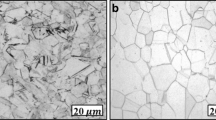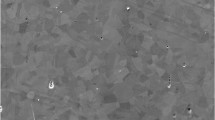Abstract
The paper presents a novel methodology to form disc springs made of metastable austenitic stainless steel using incremental sheet forming (ISF), which is also used to generate compressive residual stresses. The research aims at replacing the shot peening process which has various disadvantages such as a change in disc spring geometry and replacing it with a method that allows a better control of spring properties. Two different methodologies were developed. Firstly, ISF was used to selectively induce the residual stresses in conventionally formed disc springs. Secondly, ISF was used to form the disc spring and to induce the residual stresses during the actual forming process. Residual stresses were measured using bore-hole-drilling. For both methodologies, ISF induces higher compressive residual stresses in the disc spring and a higher spring force in comparison to conventional disc springs. The changes in the spring properties is due to the formation of deformation-induced martensite, which is characterized by using metallurgical investigations and disc compression test. Hence, the strategies developed using ISF can be employed as an alternative forming process for disc springs with integrated surface treatment.












Similar content being viewed by others
References
Talonen J, Hänninen H (2007) Formation of shear bands and strain-induced martensite during plastic deformation of metastable austenitic stainless steels. Acta Mater 55(18):6108–6118
Fahr D (1971) Stress- and strain-induced formation of martensite and its effects on strength and ductility of metastable austenitic stainless steels. Metall Trans 2(7):1883–1892
Oberg E, Jones FD, Horton HL, Ryffel HH, Geronimo, J. H. Machinery’s handbook
Doman Y (2003) Influence of residual stress on the load–deflection curve of diaphragm springs for automobile clutches. JSAE Rev 24(2):197–203
Newby M, James MN, Hattingh DG (2014) Finite element modelling of residual stresses in shot-peened steam turbine blades. Fatigue Fract Eng Mater Struct 37(7):707–716
Olmi G, Freddi A (2013) A new method for modelling the support effect under rotating bending fatigue: application to Ti-6Al-4V alloy, with and without shot peening. Fatigue Fract Eng Mater Struct 36(10):981–993
Holweger W, Walther F, Loos J, Wolf M, Schreiber J, Dreher W et al (2012) Non-destructive subsurface damage monitoring in bearings failure mode using fractal dimension analysis. Ind Lubr Tribol 64(3):132–137
Fargas G, Roa JJ, Mateo A (2015) Effect of shot peening on metastable austenitic stainless steels. Mater Sci Eng A 641:290–296
Martin U, Altenberger I, Scholtes B, Kremmer K, Oettel H (1998) Cyclic deformation and near surface microstructures of normalized shot peened steel SAE 1045. Mater Sci Eng A 246(1–2):69–80
Fathaallah R (2004) High cycle fatigue behavior prediction of shot-peened parts. Int J Fatigue 26(10):1053–1067
Emmens WC, van den Boogaard AH (2009) An overview of stabilizing deformation mechanisms in incremental sheet forming. J Mater Process Technol 209(8):3688–3695
Maqbool F, Bambach M (2017) A modular tooling set-up for incremental sheet forming (ISF) with subsequent stress-relief annealing under partial constraints. In: Author(s), p 80010
Behera AK, Ou H (2016) Effect of stress relieving heat treatment on surface topography and dimensional accuracy of incrementally formed grade 1 titanium sheet parts. Int J Adv Manuf Technol 87(9):3233–3248
Bambach M, Taleb Araghi B, Hirt G (2009) Strategies to improve the geometric accuracy in asymmetric single point incremental forming. Prod Eng Res Devel 3(2):145–156
Katajarinne T, Louhenkilpi S, Kivivuori S (2014) A novel approach to control the properties of austenitic stainless steels in incremental forming. Mater Sci Eng A 604:23–26
Kleber X, Barroso SP (2010) Investigation of shot-peened austenitic stainless steel 304L by means of magnetic Barkhausen noise. Mater Sci Eng A 527(21–22):6046–6052
Turski M, Clitheroe S, Evans AD, Rodopoulos C, Hughes DJ, Withers PJ (2010) Engineering the residual stress state and microstructure of stainless steel with mechanical surface treatments. Appl Phys A 99(3):549–556
Fu P, Zhan K, Jiang C (2013) Micro-structure and surface layer properties of 18CrNiMo7-6 steel after multistep shot peening. Mater Des 51:309–314
Halilovič M, Issa S, Wallin M, Hallberg H, Ristinmaa M (2016) Prediction of the residual state in 304 austenitic steel after laser shock peening—effects of plastic deformation and martensitic phase transformation. Int J Mech Sci 111–112:24–34
Guiheux R, Berveiller S, Kubler R, Bouscaud D, Patoor E, Puydt Q (2017) Martensitic transformation induced by single shot peening in a metastable austenitic stainless steel 301LN: experiments and numerical simulation. J Mater Process Technol 249:339–349
Brinksmeier E, Garbrecht M, Meyer D, Dong J (2008) Surface hardening by strain induced martensitic transformation. Prod Eng Res Devel 2(2):109–116
Altenberger I, Scholtes B, Martin U, Oettel H (1999) Cyclic deformation and near surface microstructures of shot peened or deep rolled austenitic stainless steel AISI 304. Mater Sci Eng A 264(1–2):1–16
Neto DM, Martins JMP, Oliveira MC, Menezes LF, Alves JL (2016) Evaluation of strain and stress states in the single point incremental forming process. Int J Adv Manuf Technol 85(1):521–534
Jiménez I, López C, Martinez-Romero O, Mares P, Siller HR, Diabb J et al (2017) Investigation of residual stress distribution in single point incremental forming of aluminum parts by X-ray diffraction technique. Int J Adv Manuf Technol 91(5):2571–2580
Rendler NJ, Vigness I (1966) Hole-drilling strain-gage method of measuring residual stresses. Exp Mech 6(12):577–586
Acknowledgements
The authors would like to thank the German Research Foundation DFG for the support of the depicted research within the priority programme ‘SPP2013’ through Project no. ‘BA 4253/6-1’ and Project no. ‘WA 1672/31-1’.
Author information
Authors and Affiliations
Corresponding author
Rights and permissions
About this article
Cite this article
Maqbool, F., Hajavifard, R., Walther, F. et al. Engineering the residual stress state of the metastable austenitic stainless steel (MASS) disc springs by incremental sheet forming (ISF). Prod. Eng. Res. Devel. 13, 139–148 (2019). https://doi.org/10.1007/s11740-018-0864-6
Received:
Accepted:
Published:
Issue Date:
DOI: https://doi.org/10.1007/s11740-018-0864-6




